Abstract
(1) Background: Acupressure is a noninvasive, low-cost technique that makes use of physical pressure on specific points using a finger or a device and shows positive effects on chronic pain as an adjunctive method to the rehabilitation exercises. The study’s aim was to evaluate the therapeutic efficacy on pain, disability, and life quality of an acupressure mat associated with a rehabilitation program in patients with chronic low back pain. (2) Methods: All participants underwent a specific rehabilitation program, initially with 10 supervised exercise sessions, then as home exercise for 6 months. The subjects in the experimental group (EG) were additionally provided with an acupressure mat and used it for 60 min per day. (3) Results: 44 patients (31 females) were equally divided among the treatment groups. A significant time interaction was found in both groups for McGill Pain Questionnaire, Oswestry Disability Index, and EuroQol-5D, and only in the EG for Visual Analog Scale. (4) Conclusions: The acupressure mat is simple and provides an additional benefit for patients in relieving pain and improving function and quality of life, especially in the medium-to-long term.
1. Introduction
Low back pain (LBP) represents a main reason for physician visits, hospitalization, or seeking other health care services [1]. In literature, the lifetime prevalence for LBP varies between 51–84%. LBP is not only common, but also holds a significant cost and health care utilization burden, as it is a leading cause of disability [2].
Chronic LBP is defined as back pain that persists for three or more months. In addition to persistent pain, many individuals often report sleep disturbances, depression, and high levels of fatigue [3,4]. The underlying cause is often not easy to detect, often because mismatches between symptoms and diagnostic results (both clinical examination and imaging) is common [5]. Therefore, the optimal treatment choice is still challenging. However, in chronic back pain patients, a multidisciplinary approach combining medical, psychological, physical, and interventional therapies appear to be the most effective treatment, considering individual patient characteristics [6,7,8].
Pharmacologic treatments are common but associated with side effects and risk of medication abuse; for this reason, nonpharmacologic interventions are important in helping to reduce symptoms and disability [9]. Current evidence-based clinical guidelines propose exercise therapy as one of the few recommended treatments for chronic LBP [10].
Unfortunately, there is no evidence showing that one form of exercise is better than another; guidelines usually recommend exercise programs based on individual needs and capabilities. Regardless, the response to such treatment is not satisfactory in many patients, with only modest changes in pain and disability [10]. Even if the reasons for the widely varying individual response are largely unknown, one factor influencing individual success may be the adherence of the patient to the treatment.
As conventional treatments often show only modest clinical effects, over the last years the utilization of alternative pain management methods is rising [11]. A subgroup of these therapies, the so called reflex therapies, acts mainly on the basis of reflex pathways via the spinal cord [12].
Among them, acupressure is a noninvasive, low-cost technique which was established and used in Traditional Chinese Medicine and makes use of physical pressure on specific points using a finger or a device [13]. Systematic reviews on acupressure support significant effects on chronic symptoms, such as pain and sleep disturbance [14]. Acupressure was also reported to positively modulate objective physiologic pain markers, such as proinflammatory and anti-inflammatory cytokines and neuropeptides [15]. A systematic review also demonstrated that the efficacy of treatment did not differ whether the acupressure was given by a therapist or self-administered, supporting its ease of use and low-cost [16]. Basing on acupressure principles, some authors proposed the use of a needle stimulation pad for patients with neck or back pain, but also for other conditions, such as headache, sleeping disorders, gastrointestinal diseases, or just for relaxation [17,18]. This device is usually composed of sharp but nonpenetrating plastic needles and the patient lies on it with the painful part of the body. The precise mechanism of action of a needle stimulation mat is not clear but probably depends on different aspects.
Mechanical skin stimulation increases local blood microcirculation and tissue metabolism processes by actively supplying oxygen and removing carbon dioxide, thus reducing the concentrations of inflammatory cytokines [19]. The mechanical stimulation of skin, subcutaneous tissue, and muscles is similar to that obtained with other complementary and alternative medicine manual and physical therapies (for example, gua sha massage and wet cupping). Such stimulation likely activates skin mechanoreceptors and even nociceptors, thus affecting the transmission and processing of sensory information to a spinal and supraspinal level [12].
Therefore, the use of a needle stimulation mat can influence pain chronicity mechanisms, that may originate at the level of the nociceptor, the spinal cord, or the brain, even when the initial injury or inflammation is no longer present [20]. Indeed, a widespread sensory hypersensitivity could be linked to central hypersensitivity, augmented central pain processing, or decreased descending pain control [21].
The purpose of this randomized controlled trial was to evaluate the therapeutic efficacy on pain and disability of a new acupressure mat device associated with a specific rehabilitation program in patients with nonspecific chronic low back pain.
2. Materials and Methods
2.1. Participants
Eligible participants were enlisted through access to clinics dedicated to back pain management in the Department of Physical and Rehabilitation Medicine of the University of Padua. Inclusion criteria in our study were nonspecific low back pain for more than 12 weeks, a rating of at least 4 cm on a 10 cm Visual Analog Scale (VAS) for the back pain, age between 18 and 80 years, and the ability to communicate in Italian. We excluded patients with a history of specific identified cause (i.e., fracture, lumbar stenosis, neoplasms, results of vertebral surgery), patients with severe psychiatric disorders and subjects with programmed spine surgery, pregnancy, uncontrolled diabetes, diseases affecting spine function or altering pain perception, coagulation disorders, skin lesions, or hypersensitivity.
2.2. Study Design
The study was designed as a prospective, randomized, single-blinded, comparative, randomized trial. The same physician was responsible for the inclusion of all the study participants. If a patient met all eligibility criteria, he/she was randomly assigned to either the experimental group (EG) or the control group (CG) by a statistical consultant. Group allocation (1:1 ratio) was based on a computer-generated randomization list and it was concealed. The single-blind model was obtained by entrusting the administration of the questionnaires and the data collection to a physician who was unaware of the delivered treatment; patients were specifically asked not to reveal which treatment group they were allocated to. The study protocol was approved by the Ethical Committee for the Clinical Trials of the University Hospital of Padua (number: 4084/AO/17). All participants gave written informed consent for participation.
2.3. Intervention
Both groups (EG) and (CG) underwent a four-week rehabilitation program composed of 10 sessions (three sessions for the first two weeks and two sessions for the last two weeks) in groups of 5 or 6 people each. EG group was provided with an acupressure mat (Mysa®) to be used daily with a 60-min session for 4 weeks (during exercise treatment).
The first session focused on patient education about the pathogenesis of pain and about the rules of postural and behavioral hygiene. The subsequent sessions focused instead on the execution of a specific protocol of exercises for the back, directed always by the same therapist. Such protocols included exercises of spine mobilization (in flexion, extension, and torsion), pelvis mobilization, postural correction, breathing, strengthening and stretching of spine, abdominal and lower limbs muscles, motor control, and core stability; they consisted of mainly open chain ground exercises, and some included the use of a fit ball. At the end of the supervised rehabilitation treatment, the subjects were trained so they could continue performing the exercises at home with 30-min sessions 3 times a week until the last followup evaluation; in particular, they were provided an illustrated brochure describing the exercises learned during the supervised sessions, their purpose, and how to perform them. In addition to this rehabilitation program, all the subjects assigned to the EG were provided with an acupressure mat (Mysa®), which is a soft mat of 715 × 430 × 10 mm in size designed based on the principles of acupressure and reflexology. It has a vegetable fiber padding and presents on its surface 33 plastic florets with pyramid-shaped tips (as illustrated in Figure 1).
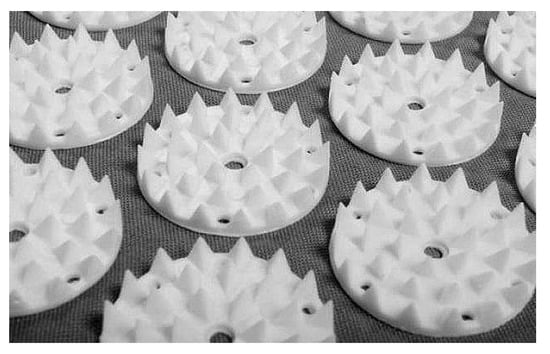
Figure 1.
Detail of acupressure mat (Mysa®) showing characteristic plastic florets with pyramid-shaped tips on its surface.
The subjects were instructed to use the mat autonomously at home every day for 60 min from the first rehabilitation session until the last follow-up evaluation. They were told to place the mat on a flat surface and lay on it with their back, initially while holding a shirt to get used to the device. Patients were prohibited from any kind of additional therapy for LBP during trial participation, including antalgic drug therapy or other kinds of rehabilitative treatment, under penalty of exclusion from the study.
2.4. Outcome Measures
A series of valid and reliable outcome measures were used to determine the different aspects related to LBP. The Visual Analog Scale (VAS) for pain intensity was used as the primary outcome measure [22]. It consists of a 100 mm horizontal line with the anchors 0 = no pain or discomfort on the left extreme and 100 = excruciating pain or discomfort on the right extreme. The McGill Pain Questionnaire [23] for pain quality, the Oswestry Disability Index (ODI) [24] for disability, and the EuroQol-5D (EQ-5D) [25] for life quality were utilized as secondary outcome measures. All these evaluation scales were assessed four times for each patient; i.e., at the baseline (T0), at the supervised treatment conclusion (T1), and then at the 3- (T3) and 6-months (T6) follow-ups.
2.5. Statistical Analysis
The sample size was calculated by setting a power of 80% and a significance level of 5% bilaterally; the enrolment of 20 subjects per group allowed us to highlight a difference of at least 25 mm in the Visual Analog Scale (primary outcome) considering a standard deviation of 30 mm and hypothesizing a coefficient of determination of 0.2 in a covariance analysis model. Data are presented as count and percentage for qualitative variables, and as mean (standard deviation) and median (minimum-maximum) for quantitative variables. The demographic and clinical characteristics of the patients at the baseline were compared with chi-square test in case of qualitative variables, and with Wilcoxon rank sum test for quantitative ones since their distribution was not normal. The treatment effect during the course of time was evaluated with the analysis of variance (ANOVA) type statistic (ATS) based on ranks to test for the effect of treatment, time, and the interaction treatment × time [26,27]. Pairwise comparisons between time points in each group were conducted with student’s t-test on ranks, and the p-values were adjusted with Bonferroni’s method. The statistical significance level was set at 5%; all statistical analyses were conducted using the SAS 9.2 program (SAS Institute Inc., Cary, NC, USA) for Windows.
3. Results
Forty-four patients (31 females and 13 males, aged between 22–80) were recruited and were equally divided among the treatment groups (22 subjects in each group). The enrolment period was from January 2018 to May 2019. As shown in the CONSORT Flow Diagram (as illustrated in Figure 2), all participants completed the proposed treatment and were included in the final analysis, as nobody was lost to follow-up or violated the protocol.
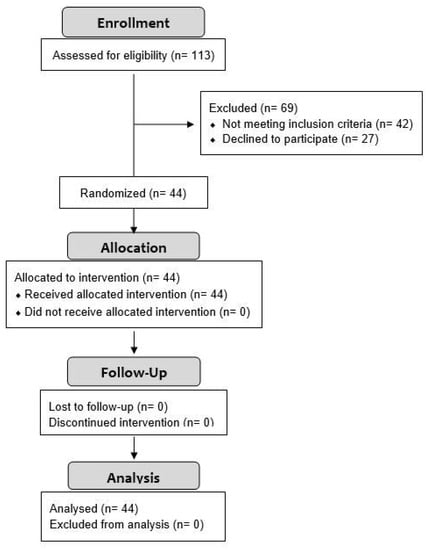
Figure 2.
CONSORT Flow Diagram showing processes of enrollment, allocation, follow-up, and analysis.
The baseline characteristics of the two groups are shown in Table 1; there were no statistically significant differences at the baseline between EG and CG both for general parameters (age, sex, body mass index, years since the onset of symptoms) and for the scores of all the analyzed evaluation scales.

Table 1.
Baseline characteristics of two groups.
In Table 2 the scores obtained at the different time points for each outcome measure are reported as mean (standard deviation) and median (minimum-maximum) for both the control and the experimental group.

Table 2.
Scores obtained in two treatment groups for all outcome measures at each timeline evaluation.
3.1. Visual Analogue Scale (Primary Outcome)
The VAS scores during the course of time revealed a significant time effect in the EG (p < 0.0001) but not in the CG (p = 0.07912). The group × time interaction was not statistically significant (p = 0.0574). The different scores at each time point are reported in table II, while Figure 3 shows the median VAS scores over time in the two treatment groups.
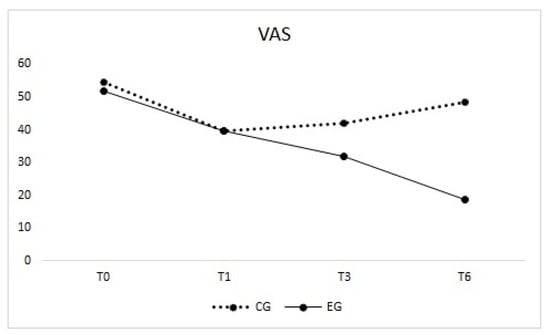
Figure 3.
Median Visual Analogue Scale (VAS) scores over time in two treatment groups.
3.2. McGill Pain Questionnaire
The statistical analysis showed a significant time effect in both groups (p = 0.00066 for the CG and p < 0.0001 for the EG), while the group × time interaction was not statistically significant (p = 0.2041). Figure 4 shows the trend of the median scores over time.
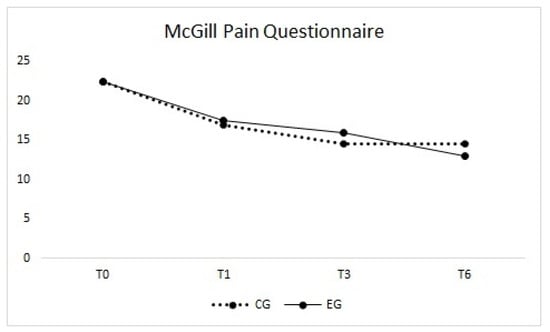
Figure 4.
Trend of McGill Pain Questionnaire median scores over time.
3.3. Oswestry Disability Index
Figure 5 shows the median scores obtained for ODI at the different time points. A significant time effect was found in both groups (p < 0.0001 for the EG and p = 0.00920 for the CG). The group × time interaction was not statistically significant (p = 0.0908).
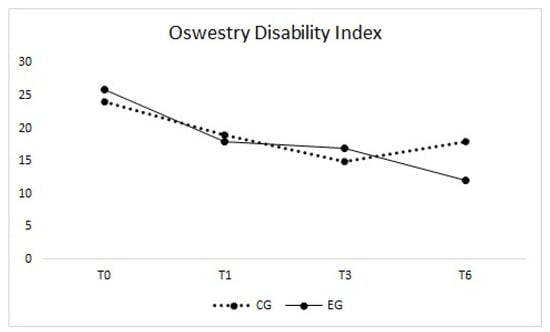
Figure 5.
Oswestry Disability Index median scores at different time points.
3.4. EuroQol-5D
This evaluation scale exhibits a symmetrical trend compared to the previous ones, as higher scores correspond to better results (as illustrated in Figure 6). As for McGill Pain Questionnaire and Oswestry Disability Index, a significant time effect was found both in the EG (p < 0.0001) and in the CG (p = 0.03970); in this case, the group × time interaction was also statistically significant (p = 0.0116).
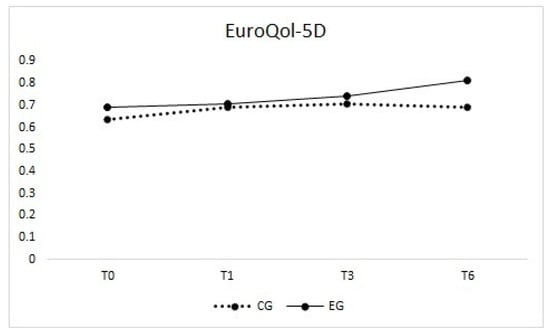
Figure 6.
Median scores of EuroQol-5D over time in two treatment groups.
3.5. Adverse Effects
Some patients in the EG complained of temporary discomfort when lying on the mat, only for the first minutes of the first sessions, but no one had to interrupt the treatment session. No significant adverse effects were reported in both groups.
4. Discussion
The objective of the present study was to evaluate the therapeutic efficacy of an acupressure mat (Mysa®) associated with a specific rehabilitation program in patients with nonspecific chronic low back pain.
Our results suggest that the rehabilitative protocol proposed to all the participants gave a significant positive effect in terms of reducing pain and disability, especially immediately after the end of the supervised sessions, while a significant improvement in life quality was found only in the experimental group.
Based on the most recent recommendations, the rehabilitative approach we proposed also included patient education about the pathogenesis of pain and about the rules of postural and behavioral hygiene. Indeed, as stated by different international guidelines, individuals with chronic LBP usually need to be provided with advice and education about the nature of low back pain to minimize disability and promote participation in physical and social activities [28,29]. Education is an easily available and inexpensive treatment option that explains to subjects how to protect their back in activities of daily living based on anatomical, physiological and ergonomic principles (the biomedical model). It also involves pain biology education, or “explaining pain”, that aims to reconsider pain as a protective output of the brain rather than a simple sign of tissue damage [30,31].
According to current evidence-based clinical guidelines, exercise therapy (of any type) is one of the few recommended treatments for chronic LBP and typically includes a graded activity or exercise program that targets improvements in function and prevention of worsening disability [10]. Indeed, many studies showed that exercise training is effective in reducing pain when compared to that of non-exercise, training-based treatments in adults [32]. Since there is no evidence showing that one form of exercise is better than another, guidelines typically recommend exercise programs that take individual needs and characteristics, preferences, and capabilities into account in deciding what type of exercise [7,33]. However, some works support the efficacy of resistance and stabilization/motor control exercise training and state that stretching exercises are most associated with pain reduction, while strengthening yields greatest functional gains [34]. In a recent review of Owen et al., exercise training was demonstrated to be more effective than hands-on therapist treatments [35].
The exercise protocol proposed in this work was directed by an expert physiotherapist. Basing on the previous literature, patients firstly underwent a clinical assessment to determine eventual signs of segmental hypo mobility or hypermobility and the progression of the exercises was directed accordingly [36]. In addition to spine mobilization exercises, the therapeutic program included muscle strengthening and stretching, motor control, and breathing exercises; they consisted of mainly open chain ground exercises, and some of them included the use of a fit ball. As Hodges and Richardson demonstrated that an alteration in the timing of core muscle activation in subjects with LBP, particular attention was placed on core stability exercises [37]. Considering the chronicity of pain and disability, the therapeutic intervention also involved the education of the patients to repeat the exercises learned in a home setting, with the aim of improving and maintaining over time the effects of the supervised rehabilitative program. The patients were provided illustrated brochures describing the exercises, their purpose and how to incorporate them into their activities of daily living. Moreover, an important factor that influences the individual success of exercise rehabilitation is represented by the patient’s adherence to the proposed treatment. In a prospective study, Mannion et al. demonstrated that the adherence to exercises has a positive correlation with the reduction of pain and disability [38]. In our trial, all patients completed all the physiotherapy sessions, and this could explain the positive results obtained by both the treatment groups. While in the short term both groups exhibited significant improvements in terms of pain relief and reduced disability, after the conclusion of the supervised rehabilitative treatment only the experimental group showed a trend of further improvement. Such better results, especially at the 6-months follow-up, are likely attributable to two aspects: first, therapeutic exercises are likely to be performed more correctly when they are supervised by a qualified therapist; second, the home use of the acupressure mat is simple and seems to give additional long-term benefits. The first aspect agrees with what Matarán–Peñarrocha et al. demonstrated in a recent study in which they compared the effectiveness of a supervised physical therapy program versus a non-supervised one on pain, functionality, fear of movement, and quality of life in patients with nonspecific chronic low back pain. Despite small differences, the patients who received supervised exercise showed more improvement in both the short and long term over the non-supervised group [39]. Similarly, in a previous randomized control trial, Bronfort et al. obtained better clinical results with supervised exercise rather than chiropractic spinal manipulation and home exercise in the treatment of chronic LBP, even if also in this case the differences between groups were small [40]. Regarding the second aspect, all the patients allocated in the experimental group referred to continue using the mat every day for 60 min until the final follow-up evaluation, as recommended.
Even if the precise mechanisms of action remain unclear, the long-term benefits related to the use of the acupressure mat were investigated in previous clinical studies and are likely attributable to several aspects, including increased local blood microcirculation and tissue metabolism processes, activation of skin mechanoreceptors, and changes in pain processing [12]. In two prospective randomized trials, Hohmann et al. investigated the effects of a two-week treatment period with a mechanical stimulation pad in patients with chronic neck or low back pain. They reported a significant pain reduction accompanied by an increase of pain pressure threshold, thus assuming that the treatment effect could be due to changes of nociceptive processing in the spinothalamic tract as well as at the level of the central nervous system [17]. In another study, Kjellgren et al. analyzed the effects of a 15 min daily rest during three weeks on a spike mat in patients with neck or low back pain. A significant reduction in experienced pain intensity and little effects in increasing optimism and energy were found. For these authors, a possible explanation of these beneficial effects could be related to the local increase in blood flow and to the gate-control theory [41]. In a randomized controlled trial, Purepong et al. investigated the effect of an acupressure backrest on pain and disability in office workers with chronic nonspecific LBP. The acupressure backrest was installed onto the office chairs of participants for one month and showed a beneficial effect on pain and disability that was maintained also at a 3-months follow-up [42]. As highlighted by Zilberter and Roman, another possible mechanism of action attributable to the acupressure mat is related to the release of endorphins into the blood stream. Indeed, different kinds of skin stimulation were demonstrated to trigger the release of these mediators that exert an endogenous stress- and pain-protective action [43]. Olsson et al. demonstrated that the use of a mechanical stimulation mat has substantial effects on the autonomous nervous system, inducing self-rated relaxation, increased back temperature, variation in blood pressure, and heart rate [17]. The reported deep relaxation contributes to well-being, and thus works through the affective-motivational component of pain [44].
In accordance to this evidence, all patients in the experimental group (EG) in our study reported a subjective feeling of general relaxation as they lay on the mat. Notably, during chronic back pain there is an alteration of back and neck sensory information, as demonstrated by Moseley and coworkers [45,46], that leads to altered back and trunk sensory perception [47]; for this reason, a perceptive rehabilitation based on training with specific surfaces can be effective in reducing pain in patients with chronic low back pain [48]. No significant adverse effects were reported in the present study. Therefore, the acupressure mat (Mysa®) can be considered a safe device, according to previous studies which highlighted only a temporary discomfort or pain experienced during the relaxation on the spike mat that decreased over time. These properties of tolerability and safety, together with the possibility of using it autonomously at home, make the acupressure mat (Mysa®) a valid tool for the long-term management of subjects suffering from chronic low back pain. This study has some limitations: the sample size was relatively small, and the follow-up period was relatively short, especially if related to the typical long-term chronic course of the disease in question. Another significant limitation was the lack of a “sham” acupressure procedure that could reduce the possible influence of placebo effect and psychological factors, especially in pain perception mechanisms. Furthermore, we did not use specific instruments to monitor the home use of the mat and adherence to home exercises; we instead relied on what the patients reported, that is, a high adherence to the use of the mat. For all these reasons, randomized controlled trials with longer follow-up periods and precise monitoring of mat use and adherence to home exercises are needed to further confirm our findings.
5. Conclusions
According to the previous literature, this study confirms the therapeutic effects of exercise on pain and consequently on disability in the management of subjects with chronic low back pain. Furthermore, the additional use of the acupressure mat (Mysa®) increases benefits in terms of relieving pain, and consequently, in ameliorating functionality and improving quality of life, especially at the medium-to-long term follow-up. Tolerability, safety, and the possibility of using this acupressure mat at home makes this device a valid tool for the long-term management of low back pain.
Author Contributions
A.F. and P.F. conceived and designed the study; A.F. was responsible for eligibility and inclusion of all study participants; G.P. was responsible for group allocation based on a computer-generated randomization list; P.F. administrated questionnaires and collected data; C.L.S. followed all patients during rehabilitation pathway; S.M. verified analytical methods and supervised project; P.F., G.M., and A.F. drafted manuscript with input from all authors. All authors discussed the results and contributed to the final manuscript. All authors have read and agreed to the published version of the manuscript.
Funding
This research received no external funding.
Institutional Review Board Statement
Not applicable.
Informed Consent Statement
Informed consent was obtained from all subjects involved in the study.
Data Availability Statement
Not applicable.
Conflicts of Interest
The authors declare no conflict of interest.
References
- Andersson, G.B. Epidemiological features of chronic low-back pain. Lancet 1999, 354, 581–585. [Google Scholar] [CrossRef]
- Strine, T.W.; Hootman, J.M. US national prevalence and correlates of low back and neck pain among adults. Arthritis Rheum. 2007, 57, 656–665. [Google Scholar] [CrossRef] [PubMed]
- Uchmanowicz, I.; Kołtuniuk, A.; Stępień, A.; Uchmanowicz, B.; Rosińczuk, J. The influence of sleep disorders on the quality of life in patients with chronic low back pain. Scand. J. Caring Sci. 2019, 33, 119–127. [Google Scholar] [CrossRef] [PubMed]
- Snekkevik, H.; Eriksen, H.R.; Tangen, T.; Chalder, T.; Reme, S.E. Fatigue and depression in sick-listed chronic low back pain patients. Pain Med. 2014, 15, 1163–1170. [Google Scholar] [CrossRef] [PubMed]
- Boden, S.D.; Davis, D.O.; Dina, T.S.; Patronas, N.J.; Wiesel, S.W. Abnormal magnetic-resonance scans of the lumbar spine in asymptomatic subjects. A prospective investigation. J. Bone Jt. Surg. Am. 1990, 72, 403–408. [Google Scholar] [CrossRef]
- Elkayam, O.; Ben Itzhak, S.; Avrahami, E.; Meidan, Y.; Doron, N.; Eldar, I.; Keidar, I.; Liram, N.; Yaron, M. Multidisciplinary approach to chronic back pain: Prognostic elements of the outcome. Clin. Exp. Rheumatol. 1996, 14, 281–288. [Google Scholar] [PubMed]
- Hayden, J.A.; Wilson, M.N.; Stewart, S.; Cartwright, J.L.; Smith, A.O.; Riley, R.D.; van Tulder, M.; Tom Bendix, T.; Cecchi, F.; Costa, L.O.P.; et al. Chronic Low Back Pain IPD Meta-Analysis Group. Exercise treatment effect modifiers in persistent low back pain: An individual participant data meta-analysis of 3514 participants from 27 randomised controlled trials. Br. J. Sports Med. 2020, 54, 1277–1278. [Google Scholar] [CrossRef]
- Frizziero, A.; Pellizzon, G.; Vittadini, F.; Bigliardi, D.; Costantino, C. Efficacy of Core Stability in Non-Specific Chronic Low Back Pain. J. Funct. Morphol. Kinesiol. 2021, 6, 37. [Google Scholar] [CrossRef]
- Martell, B.A.; O’Connor, P.G.; Kerns, R.D.; Becker, W.C.; Morales, K.H.; Kosten, T.R.; Fiellin, D.A. Systematic review: Opioid treatment for chronic back pain: Prevalence, efficacy, and association with addiction. Ann. Intern. Med. 2007, 146, 116–127. [Google Scholar] [CrossRef]
- Airaksinen, O.; Brox, J.I.; Cedraschi, C.; Hildebrandt, J.; Klaber-Moffett, J.; Kovacs, F.; Mannion, A.F.; Reis, S.; Staal, J.B.; Ursin, H.; et al. Chapter 4. European guidelines for the management of chronic nonspecific low back pain. Eur. Spine J. Off. Publ. Eur. Spine Soc. Eur. Spinal Deform. Soc. Sect. Cerv. Spine Res. Soc. 2006, 15 (Suppl. 2), S192–S300. [Google Scholar] [CrossRef] [PubMed]
- Herman, P.M.; Szczurko, O.; Cooley, K.; Mills, E.J. Cost-effectiveness of naturopathic care for chronic low back pain. Altern. Ther. Health Med. 2008, 14, 32–39. [Google Scholar]
- Musial, F.; Michalsen, A.; Dobos, G. Functional chronic pain syndromes and naturopathic treatments: Neurobiological foundations. Forsch. Komplement. 2008, 15, 97–103. [Google Scholar] [CrossRef] [PubMed]
- Adams, A.; Eschman, J.; Ge, W. Acupressure for chronic low back pain: A single system study. J. Phys. Ther. Sci. 2017, 29, 1416–1420. [Google Scholar] [CrossRef][Green Version]
- Chen, Y.W.; Wang, H.H. The effectiveness of acupressure on relieving pain: A systematic review. Pain Manag. Nurs. Off. J. Am. Soc. Pain Manag. Nurses 2014, 15, 539–550. [Google Scholar] [CrossRef] [PubMed]
- Monson, E.; Arney, D.; Benham, B.; Bird, R.; Elias, E.; Linden, K.; McCord, K.; Miller, C.; Miller, T.; Ritter, L.; et al. Beyond Pills: Acupressure Impact on Self-Rated Pain and Anxiety Scores. J. Altern. Complement. Med. 2019, 25, 517–521. [Google Scholar] [CrossRef] [PubMed]
- Godley, E.; Smith, M.A. Efficacy of acupressure for chronic low back pain: A systematic review. Complement. Ther. Clin. Pract. 2020, 39, 101146. [Google Scholar] [CrossRef] [PubMed]
- Olsson, E.M.; von Schéele, B. Relaxing on a bed of nails: An exploratory study of the effects on the autonomic, cardiovascular, and respiratory systems, and saliva cortisol. J. Altern. Complement. Med. 2011, 17, 5–12. [Google Scholar] [CrossRef] [PubMed]
- Hohmann, C.; Ullrich, I.; Lauche, R.; Choi, K.E.; Lüdtke, R.; Rolke, R.; Cramer, H.; Saha, F.J.; Rampp, T.; Michalsen, A.; et al. The benefit of a mechanical needle stimulation pad in patients with chronic neck and lower back pain: Two randomized controlled pilot studies. Evid. Based Complement. Altern. Med. eCAM 2012, 2012, 753583. [Google Scholar] [CrossRef]
- Best, T.M.; Gharaibeh, B.; Huard, J. Stem cells, angiogenesis and muscle healing: A potential role in massage therapies? Br. J. Sports Med. 2013, 47, 556–560. [Google Scholar] [CrossRef] [PubMed]
- Musial, F.; Spohn, D.; Rolke, R. Naturopathic reflex therapies for the treatment of chronic back and neck pain—Part 1: Neurobiological foundations. Forsch. Komplement. 2013, 20, 219–224. [Google Scholar] [CrossRef]
- Graven-Nielsen, T.; Arendt-Nielsen, L. Assessment of mechanisms in localized and widespread musculoskeletal pain. Nat. Rev. Rheumatol. 2010, 6, 599–606. [Google Scholar] [CrossRef] [PubMed]
- Williamson, A.; Hoggart, B. Pain: A review of three commonly used pain rating scales. J. Clin. Nurs. 2005, 14, 798–804. [Google Scholar] [CrossRef]
- Melzack, R. The McGill Pain Questionnaire: Major properties and scoring methods. Pain 1975, 1, 277–299. [Google Scholar] [CrossRef]
- Fairbank, J.C.; Pynsent, P.B. The Oswestry Disability Index. Spine 2000, 25, 2940–2952. [Google Scholar] [CrossRef]
- Balestroni, G.; Bertolotti, G. L’EuroQol-5D (EQ-5D): Uno strumento per la misura della qualità della vita (EuroQol-5D (EQ-5D): An instrument for measuring quality of life). Monaldi Arch. Chest Dis. Arch. Monaldi Mal. Torace 2012, 78, 155–159. [Google Scholar] [CrossRef]
- Akritas, M.G.; Brunner, E. A unified approach to rank tests for mixed models. J. Stat. Plan. Inference 1997, 61, 249–277. [Google Scholar] [CrossRef]
- Shah, D.A.; Madden, L.V. Nonparametric analysis of ordinal data in designed factorial experiments. Phytopathology 2004, 94, 33–43. [Google Scholar] [CrossRef]
- National Guideline Centre (UK). Low Back Pain and Sciatica in over 16s: Assessment and Management; National Institute for Health and Care Excellence: London, UK, 2016. [Google Scholar]
- Koes, B.W.; van Tulder, M.; Lin, C.W.; Macedo, L.G.; McAuley, J.; Maher, C. An updated overview of clinical guidelines for the management of non-specific low back pain in primary care. Eur. Spine J. Off. Publ. Eur. Spine Soc. Eur. Spinal Deform. Soc. Eur. Sect. Cerv. Spine Res. Soc. 2010, 19, 2075–2094. [Google Scholar] [CrossRef]
- Dupeyron, A.; Ribinik, P.; Gélis, A.; Genty, M.; Claus, D.; Hérisson, C.; Coudeyre, E. Education in the management of low back pain: Literature review and recall of key recommendations for practice. Ann. Phys. Rehabil. Med. 2011, 54, 319–335. [Google Scholar] [CrossRef]
- Butler, D.S.; Moseley, G.L. Explain Pain, 2nd ed.; Noigroup Publications: Adelaide, Australia, 2013. [Google Scholar]
- Searle, A.; Spink, M.; Ho, A.; Chuter, V. Exercise interventions for the treatment of chronic low back pain: A systematic review and meta-analysis of randomised controlled trials. Clin. Rehabil. 2015, 29, 1155–1167. [Google Scholar] [CrossRef] [PubMed]
- Foster, N.E.; Anema, J.R.; Cherkin, D.; Chou, R.; Cohen, S.P.; Gross, D.P.; Ferreira, P.H.; Fritz, J.M.; Koes, B.W.; Peul, W.; et al. Prevention and treatment of low back pain: Evidence, challenges, and promising directions. Lancet 2018, 391, 2368–2383. [Google Scholar] [CrossRef]
- Urits, I.; Burshtein, A.; Sharma, M.; Testa, L.; Gold, P.A.; Orhurhu, V.; Viswanath, O.; Jones, M.R.; Sidransky, M.A.; Spektor, B.; et al. Low Back Pain, a Comprehensive Review: Pathophysiology, Diagnosis, and Treatment. Curr. Pain Headache Rep. 2019, 23, 23. [Google Scholar] [CrossRef]
- Owen, P.J.; Miller, C.T.; Mundell, N.L.; Verswijveren, S.; Tagliaferri, S.D.; Brisby, H.; Bowe, S.J.; Belavy, D.L. Which specific modes of exercise training are most effective for treating low back pain? Network meta-analysis. Br. J. Sports Med. 2020, 54, 1279–1287. [Google Scholar] [CrossRef]
- O’Sullivan, P.B. Lumbar segmental ‘instability’: Clinical presentation and specific stabilizing exercise management. Man. Ther. 2000, 5, 2–12. [Google Scholar] [CrossRef] [PubMed]
- Hodges, P.W.; Richardson, C.A. Inefficient muscular stabilization of the lumbar spine associated with low back pain. A motor control evaluation of transversus abdominis. Spine 1996, 21, 2640–2650. [Google Scholar] [CrossRef]
- Mannion, A.F.; Helbling, D.; Pulkovski, N.; Sprott, H. Spinal segmental stabilisation exercises for chronic low back pain: Programme adherence and its influence on clinical outcome. Eur. Spine J. Off. Publ. Eur. Spine Soc. Eur. Spinal Deform. Soc. Eur. Sect. Cerv. Spine Res. Soc. 2009, 18, 1881–1891. [Google Scholar] [CrossRef]
- Matarán-Peñarrocha, G.A.; Lara Palomo, I.C.; Antequera Soler, E.; Gil-Martínez, E.; Fernández-Sánchez, M.; Aguilar-Ferrándiz, M.E.; Castro-Sánchez, A.M. Comparison of efficacy of a supervised versus non-supervised physical therapy exercise program on the pain, functionality and quality of life of patients with non-specific chronic low-back pain: A randomized controlled trial. Clin. Rehabil. 2020, 34, 948–959. [Google Scholar] [CrossRef]
- Bronfort, G.; Maiers, M.J.; Evans, R.L.; Schulz, C.A.; Bracha, Y.; Svendsen, K.H.; Grimm, R.H., Jr.; Owens, E.F., Jr.; Garvey, T.A.; Transfeldt, E.E. Supervised exercise, spinal manipulation, and home exercise for chronic low back pain: A randomized clinical trial. Spine J. Off. J. N. Am. Spine Soc. 2011, 11, 585–598. [Google Scholar] [CrossRef]
- Kjellgren, A.; Erdefelt, K.; Werngren, L.; Norlander, T. Does relaxation on a bed of nails (spike mat) induce beneficial effects? A randomized controlled pilot study. Altern. Med. Stud. 2011, 1, e5. [Google Scholar] [CrossRef]
- Purepong, N.; Channak, S.; Boonyong, S.; Thaveeratitham, P.; Janwantanakul, P. The effect of an acupressure backrest on pain and disability in office workers with chronic low back pain: A randomized, controlled study and patients’ preferences. Complement. Ther. Med. 2015, 23, 347–355. [Google Scholar] [CrossRef]
- Zilberter, T.; Roman, J. Reflexo-therapy with mechanical skin stimulation: Pilot study. In Proceedings of the Symposium on Integrative Medicine, New York, NY, USA, 26–28 May 1999. [Google Scholar]
- Treede, R.D.; Kenshalo, D.R.; Gracely, R.H.; Jones, A.K. The cortical representation of pain. Pain 1999, 79, 105–111. [Google Scholar] [CrossRef]
- Moseley, L.G.; Zalucki, N.M.; Wiech, K. Tactile discrimination, but not tactile stimulation alone, reduces chronic limb pain. Pain 2008, 137, 600–608. [Google Scholar] [CrossRef]
- Moseley, L.G. I can’t find it! Distorted body image and tactile dysfunction in patients with chronic back pain. Pain 2008, 140, 239–243. [Google Scholar] [CrossRef]
- Lee, A.S.; Cholewicki, J.; Reeves, N.P.; Zazulak, B.T.; Mysliwiec, L.W. Comparison of trunk proprioception between patients with low back pain and healthy controls. Arch. Phys. Med. Rehabil. 2010, 91, 1327–1331. [Google Scholar] [CrossRef]
- Morone, G.; Iosa, M.; Paolucci, T.; Fusco, A.; Alcuri, R.; Spadini, E.; Saraceni, V.M.; Paolucci, S. Efficacy of perceptive rehabilitation in the treatment of chronic nonspecific low back pain through a new tool: A randomized clinical study. Clin. Rehabil. 2012, 26, 339–350. [Google Scholar] [CrossRef]
Publisher’s Note: MDPI stays neutral with regard to jurisdictional claims in published maps and institutional affiliations. |
© 2021 by the authors. Licensee MDPI, Basel, Switzerland. This article is an open access article distributed under the terms and conditions of the Creative Commons Attribution (CC BY) license (https://creativecommons.org/licenses/by/4.0/).